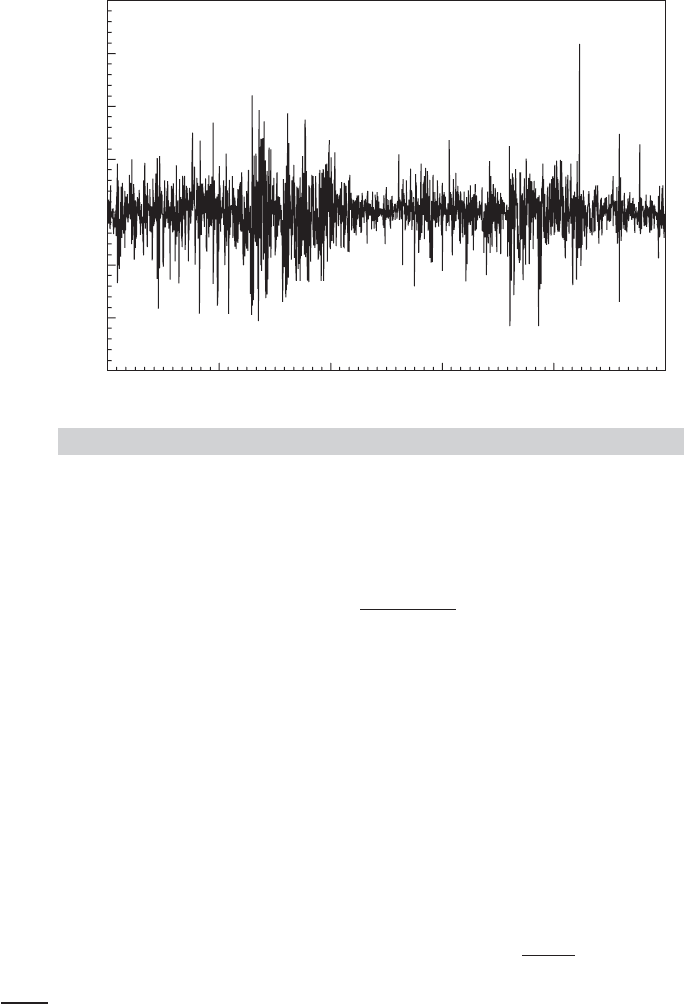Greene W.H. Econometric Analysis
Подождите немного. Документ загружается.


CHAPTER 20
✦
Serial Correlation
929
is statistically significant in this auxiliary, second-step regression. Another indicator is
provided by the FGLS residuals, themselves. After computing the FGLS regression,
the estimated residuals,
ˆε = y
t
− x
t
ˆ
β
will still be autocorrelated. In our results using the Prais–Winsten estimates, the auto-
correlation of the FGLS residuals is 0.957. The associated Durbin–Watson statistic is
0.0867. This is to be expected. However, if the model is correct, then the transformed
residuals
ˆu
t
= ˆε
t
− ˆρ ˆε
t−1
should be at least close to nonautocorrelated. But, for our data, the autocorrelation of
these adjusted residuals is only 0.292 with a Durbin–Watson statistic of 1.416. The value
of d
L
for one regressor (u
t−1
) and 50 observations is 1.50. It appears on this basis that,
in fact, the AR(1) model has largely completed the specification.
20.9.3 ESTIMATION WITH A LAGGED DEPENDENT VARIABLE
In Section 20.5.1, we considered the problem of estimation by least squares when the
model contains both autocorrelation and lagged dependent variable(s). Because the
OLS estimator is inconsistent, the residuals on which an estimator of ρ would be based
are likewise inconsistent. Therefore, ˆρ will be inconsistent as well. The consequence
is that the FGLS estimators described earlier are not usable in this case. There is,
however, an alternative way to proceed, based on the method of instrumental variables.
The method of instrumental variables was introduced in Section 8.3.2. To review, the
general problem is that in the regression model, if
plim(1/T )X
ε = 0,
then the least squares estimator is not consistent. A consistent estimator is
b
IV
= (Z
X)
−1
(Z
y),
where Z is a set of K variables chosen such that plim(1/T)Z
ε = 0 but plim(1/T)Z
X =
0. For the purpose of consistency only, any such set of instrumental variables will suffice.
The relevance of that here is that the obstacle to consistent FGLS is, at least for the
present, is the lack of a consistent estimator of ρ. By using the technique of instrumental
variables, we may estimate β consistently, then estimate ρ and proceed.
Hatanaka (1974, 1976) has devised an efficient two-step estimator based on this prin-
ciple. To put the estimator in the current context, we consider estimation of the model
y
t
= x
t
β + γ y
t−1
+ ε
t
,
ε
t
= ρε
t−1
+ u
t
.
To get to the second step of FGLS, we require a consistent estimator of the slope pa-
rameters. These estimates can be obtained using an IV estimator, where the column
of Z corresponding to y
t−1
is the only one that need be different from that of X.An
appropriate instrument can be obtained by using the fitted values in the regression of
y
t
on x
t
and x
t−1
. The residuals from the IV regression are then used to construct
ˆρ =
T
t=3
ˆε
t
ˆε
t−1
T
t=3
ˆε
2
t
, (20-33)

930
PART V
✦
Time Series and Macroeconometrics
where
ˆε
t
= y
t
− b
IV
x
t
− c
IV
y
t−1
.
FGLS estimates may now be computed by regressing y
∗
t
= y
t
− ˆρ y
t−1
on
x
∗
t
= x
t
− ˆρx
t−1
,
y
∗
t−1
= y
t−1
− ˆρ y
t−2
,
ˆε
t−1
= y
t−1
− b
IV
x
t−1
− c
IV
y
t−2
.
Let d be the coefficient on ˆε
t−1
in this regression. The efficient estimator of ρ is
ˆ
ˆρ = ˆρ + d.
Appropriate asymptotic standard errors for the estimators, including
ˆ
ˆρ, are obtained
from the s
2
[X
∗
X
∗
]
−1
computed at the second step. Hatanaka shows that these estimators
are asymptotically equivalent to maximum likelihood estimators.
15
20.10 AUTOREGRESSIVE CONDITIONAL
HETEROSCEDASTICITY
Heteroscedasticity is often associated with cross-sectional data, whereas time series are
usually studied in the context of homoscedastic processes. In analyses of macroeconomic
data, Engle (1982, 1983) and Cragg (1982) found evidence that for some kinds of data,
the disturbance variances in time-series models were less stable than usually assumed.
Engle’s results suggested that in models of inflation, large and small forecast errors
appeared to occur in clusters, suggesting a form of heteroscedasticity in which the
variance of the forecast error depends on the size of the previous disturbance. He
suggested the autoregressive, conditionally heteroscedastic, or ARCH, model as an
alternative to the usual time-series process. More recent studies of financial markets
suggest that the phenomenon is quite common. The ARCH model has proven to be
useful in studying the volatility of inflation [Coulson and Robins (1985)], the term
structure of interest rates [Engle, Hendry, and Trumble (1985)], the volatility of stock
market returns [Engle, Lilien, and Robins (1987)], and the behavior of foreign exchange
markets [Domowitz and Hakkio (1985) and Bollerslev and Ghysels (1996)], to name
but a few. This section will describe specification, estimation, and testing, in the basic
formulations of the ARCH model and some extensions.
16
Example 20.5 Stochastic Volatility
Figure 20.5 shows Bollerslev and Ghysel’s 1974 data on the daily percentage nominal return
for the Deutschmark/Pound exchange rate. (These data are given in Appendix Table F20.1.)
The variation in the series appears to be fluctuating, with several clusters of large and small
movements.
15
See Section 14.9.2.b.
16
Engle and Rothschild (1992) give a survey of this literature which describes many extensions. Mills (1993)
also presents several applications. See, as well, Bollerslev (1986) and Li, Ling, and McAleer (2001). See
McCullough and Renfro (1999) for discussion of estimation of this model.

CHAPTER 20
✦
Serial Correlation
931
0 395 790 1185
Observation Number
Y
1580 1975
3
2
1
4
3
2
1
0
FIGURE 20.5
Nominal Exchange Rate Returns.
20.10.1 THE ARCH(1) MODEL
The simplest form of this model is the ARCH(1) model,
y
t
= x
t
β + ε
t
,
ε
t
= u
t
α
0
+ α
1
ε
2
t−1
,
(20-34)
where u
t
is distributed as standard normal.
17
It follows that E [ε
t
|x
t
,ε
t−1
] = 0, so that
E [ε
t
|x
t
] = 0 and E [y
t
|x
t
] = x
t
β. Therefore, this model is a classical regression model.
But
Var[ε
t
|ε
t−1
] = E
ε
2
t
*
*
ε
t−1
= E
u
2
t
α
0
+ α
1
ε
2
t−1
= α
0
+ α
1
ε
2
t−1
,
so ε
t
is conditionally heteroscedastic, not with respect to x
t
as we considered in Chapter 9,
but with respect to ε
t−1
. The unconditional variance of ε
t
is
Var[ε
t
] = Va r
E [ε
t
|ε
t−1
]
+ E
Var[ε
t
|ε
t−1
]
= α
0
+ α
1
E
ε
2
t−1
= α
0
+ α
1
Var[ε
t−1
].
If the process generating the disturbances is weakly (covariance) stationary (see Defi-
nition 19.2),
18
then the unconditional variance is not changing over time so
Var[ε
t
] = Var[ε
t−1
] = α
0
+ α
1
Var[ε
t−1
] =
α
0
1 − α
1
.
17
The assumption that u
t
has unit variance is not a restriction. The scaling implied by any other variance
would be absorbed by the other parameters.
18
This discussion will draw on the results and terminology of time-series analysis in Section 20.3. The reader
may wish to peruse this material at this point.

932
PART V
✦
Time Series and Macroeconometrics
For this ratio to be finite and positive, |α
1
| must be less than 1. Then, unconditionally,
ε
t
is distributed with mean zero and variance σ
2
= α
0
/(1 − α
1
). Therefore, the model
obeys the classical assumptions, and ordinary least squares is the most efficient linear
unbiased estimator of β.
But there is a more efficient nonlinear estimator. The log-likelihood function for
this model is given by Engle (1982). Conditioned on starting values y
0
and x
0
(and ε
0
),
the conditional log-likelihood for observations t = 1,...,T is the one we examined in
Section 14.9.2.a for the general heteroscedastic regression model [see (14-52)],
ln L =−
T
2
ln(2π) −
1
2
T
t=1
ln
α
0
+ α
1
ε
2
t−1
−
1
2
T
t=1
ε
2
t
α
0
+ α
1
ε
2
t−1
,ε
t
= y
t
− β
x
t
.
(20-35)
Maximization of log L can be done with the conventional methods, as discussed in
Appendix E.
19
20.10.2 ARCH(
q
), ARCH-IN-MEAN, AND GENERALIZED
ARCH MODELS
The natural extension of the ARCH(1) model presented before is a more general model
with longer lags. The ARCH(q) process,
σ
2
t
= α
0
+ α
1
ε
2
t−1
+ α
2
ε
2
t−2
+···+α
q
ε
2
t−q
,
is a qth order moving average [MA(q)] process. [Once again, see Engle (1982).] This
section will generalize the ARCH(q) model, as suggested by Bollerslev (1986), in the
direction of the autoregressive-moving average (ARMA) models of Section 22.2.1. The
discussion will parallel his development, although many details are omitted for brevity.
The reader is referred to that paper for background and for some of the less critical
details.
Among the many variants of the capital asset pricing model (CAPM) is an intertem-
poral formulation by Merton (1980) that suggests an approximate linear relationship
between the return and variance of the market portfolio. One of the possible flaws
in this model is its assumption of a constant variance of the market portfolio. In this
connection, then, the ARCH-in-Mean, or ARCH-M, model suggested by Engle, Lilien,
and Robins (1987) is a natural extension. The model states that
y
t
= β
x
t
+ δσ
2
t
+ ε
t
,
Var[ε
t
|
t
] = ARCH(q).
Among the interesting implications of this modification of the standard model is that
under certain assumptions, δ is the coefficient of relative risk aversion. The ARCH-M
model has been applied in a wide variety of studies of volatility in asset returns, including
19
Engle (1982) and Judge et al. (1985, pp. 441– 444) suggest a four-step procedure based on the method
of scoring that resembles the two-step method we used for the multiplicative heteroscedasticity model in
Section 8.8.1. However, the full MLE is now incorporated in most modern software, so the simple regres-
sion based methods, which are difficult to generalize, are less attractive in the current literature. But, see
McCullough and Renfro (1999) and Fiorentini, Calzolari, and Panattoni (1996) for commentary and some
cautions related to maximum likelihood estimation.

CHAPTER 20
✦
Serial Correlation
933
the daily Standard and Poor’s Index [French, Schwert, and Stambaugh (1987)] and
weekly New York Stock Exchange returns [Chou (1988)]. A lengthy list of applications
is given in Bollerslev, Chou, and Kroner (1992).
The ARCH-M model has several noteworthy statistical characteristics. Unlike the
standard regression model, misspecification of the variance function does affect the
consistency of estimators of the parameters of the mean. [See Pagan and Ullah (1988)
for formal analysis of this point.] Recall that in the classical regression setting, weighted
least squares is consistent even if the weights are misspecified as long as the weights are
uncorrelated with the disturbances. That is not true here. If the ARCH part of the model
is misspecified, then conventional estimators of β and δ will not be consistent. Bollerslev,
Chou, and Kroner (1992) list a large number of studies that called into question the
specification of the ARCH-M model, and they subsequently obtained quite different
results after respecifying the model. A closely related practical problem is that the
mean and variance parameters in this model are no longer uncorrelated. In analysis
up to this point, we made quite profitable use of the block diagonality of the Hessian
of the log-likelihood function for the model of heteroscedasticity. But the Hessian for
the ARCH-M model is not block diagonal. In practical terms, the estimation problem
cannot be segmented as we have done previously with the heteroscedastic regression
model. All the parameters must be estimated simultaneously.
The model of generalized autoregressive conditional heteroscedasticity (GARCH)
is defined as follows.
20
The underlying regression is the usual one in (20-34). Conditioned
on an information set at time t, denoted
t
, the distribution of the disturbance is assumed
to be
ε
t
|
t
∼ N
0,σ
2
t
,
where the conditional variance is
σ
2
t
= α
0
+ δ
1
σ
2
t−1
+ δ
2
σ
2
t−2
+···+δ
p
σ
2
t−p
+ α
1
ε
2
t−1
+ α
2
ε
2
t−2
+···+α
q
ε
2
t−q
. (20-36)
Define
z
t
=
1,σ
2
t−1
,σ
2
t−2
,...,σ
2
t−p
,ε
2
t−1
,ε
2
t−2
,...,ε
2
t−q
and
γ = [α
0
,δ
1
,δ
2
,...,δ
p
,α
1
,...,α
q
]
= [α
0
, δ
, α
]
.
Then
σ
2
t
= γ
z
t
.
Notice that the conditional variance is defined by an autoregressive-moving average
[ARMA ( p, q)] process in the innovations ε
2
t
. The difference here is that the mean of
the random variable of interest y
t
is described completely by a heteroscedastic, but
otherwise ordinary, regression model. The conditional variance, however, evolves over
time in what might be a very complicated manner, depending on the parameter values
and on p and q. The model in (20-36) is a GARCH(p, q) model, where p refers, as
20
As have most areas in time-series econometrics, the line of literature on GARCH models has progressed
rapidly in recent years and will surely continue to do so. We have presented Bollerslev’s model in some detail,
despite many recent extensions, not only to introduce the topic as a bridge to the literature, but also because it
provides a convenient and interesting setting in which to discuss several related topics such as double-length
regression and pseudo–maximum likelihood estimation.

934
PART V
✦
Time Series and Macroeconometrics
before, to the order of the autoregressive part.
21
As Bollerslev (1986) demonstrates with
an example, the virtue of this approach is that a GARCH model with a small number
of terms appears to perform as well as or better than an ARCH model with many.
The stationarity conditions are important in this context to ensure that the moments
of the normal distribution are finite. The reason is that higher moments of the normal
distribution are finite powers of the variance. A normal distribution with variance σ
2
t
has fourth moment 3σ
4
t
, sixth moment 15σ
6
t
, and so on. [The precise relationship of
the even moments of the normal distribution to the variance is μ
2k
=(σ
2
)
k
(2k)!/(k!2
k
).]
Simply ensuring that σ
2
t
is stable does not ensure that higher powers are as well.
22
Bollerslev presents a useful figure that shows the conditions needed to ensure stability
for moments up to order 12 for a GARCH(1, 1) model and gives some additional
discussion. For example, for a GARCH(1, 1) process, for the fourth moment to exist,
3α
2
1
+ 2α
1
δ
1
+ δ
2
1
must be less than 1.
It is convenient to write (20-36) in terms of polynomials in the lag operator;
σ
2
t
= α
0
+ D(L)σ
2
t
+ A(L)ε
2
t
.
The stationarity condition for such an equation is that the roots of the characteristic
equation, 1 − D(z) = 0, must lie outside the unit circle. For the present, we will as-
sume that this case is true for the model we are considering and that A(1) + D(1)<1.
[This assumption is stronger than that needed to ensure stationarity in a higher-order
autoregressive model, which would depend only on D(L).] The implication is that the
GARCH process is covariance stationary with E [ε
t
] = 0 (unconditionally), Var[ε
t
] =
α
0
/[1 − A(1) − D(1)], and Cov[ε
t
,ε
s
] = 0 for all t = s. Thus, unconditionally the model
is the classical regression model that we examined in Chapters 2–6.
The usefulness of the GARCH specification is that it allows the variance to evolve
over time in a way that is much more general than the simple specification of the ARCH
model. For the example discussed in his paper, Bollerslev reports that although Engle
and Kraft’s (1983) ARCH(8) model for the rate of inflation in the GNP deflator appears
to remove all ARCH effects, a closer look reveals GARCH effects at several lags. By
fitting a GARCH(1, 1) model to the same data, Bollerslev finds that the ARCH effects
out to the same eight-period lag as fit by Engle and Kraft and his observed GARCH
effects are all satisfactorily accounted for.
20.10.3 MAXIMUM LIKELIHOOD ESTIMATION
OF THE GARCH MODEL
Bollerslev describes a method of estimation based on the BHHH algorithm. As he
shows, the method is relatively simple, although with the line search and first derivative
method that he suggests, it probably involves more computation and more iterations
than necessary. Following the suggestions of Harvey (1976), it turns out that there is a
simpler way to estimate the GARCH model that is also very illuminating. This model is
actually very similar to the more conventional model of multiplicative heteroscedasticity
that we examined in Section 14.9.2.a.
21
We have changed Bollerslev’s notation slightly so as not to conflict with our previous presentation. He used
β instead of our δ in (20-36) and b instead of our β in (20-34).
22
The conditions cannot be imposed a priori. In fact, there is no nonzero set of parameters that guarantees
stability of all moments, even though the normal distribution has finite moments of all orders. As such, the
normality assumption must be viewed as an approximation.

CHAPTER 20
✦
Serial Correlation
935
For normally distributed disturbances, the log-likelihood for a sample of T obser-
vations is
23
ln L =
T
t=1
−
1
2
ln(2π) + ln σ
2
t
+
ε
2
t
σ
2
t
=
T
t=1
ln f
t
(θ) =
T
t=1
l
t
(θ),
where ε
t
= y
t
−x
t
β and θ = (β
, α
0
, α
, δ
)
= (β
, γ
)
. Derivatives of ln L are obtained
by summation. Let l
t
denote ln f
t
(θ). The first derivatives with respect to the variance
parameters are
∂l
t
∂γ
=−
1
2
1
σ
2
t
−
ε
2
t
σ
2
t
2
∂σ
2
t
∂γ
=
1
2
1
σ
2
t
∂σ
2
t
∂γ
ε
2
t
σ
2
t
− 1
=
1
2
1
σ
2
t
g
t
v
t
= b
t
v
t
.
(20-37)
Note that E [v
t
] = 0. Suppose, for now, that there are no regression parameters.
Newton’s method for estimating the variance parameters would be
ˆγ
i+1
= ˆγ
i
− H
−1
g, (20-38)
where H indicates the Hessian and g is the first derivatives vector. Following Harvey’s
suggestion (see Section 14.9.2.a), we will use the method of scoring instead. To do this,
we make use of E [v
t
] =0 and E [ε
2
t
/σ
2
t
] =1. After taking expectations in (20-37), the it-
eration reduces to a linear regression of v
∗
t
=(1/
√
2)v
t
on regressors w
∗
t
=(1/
√
2)g
t
/σ
2
t
.
That is,
ˆγ
i+1
= ˆγ
i
+ [W
∗
W
∗
]
−1
W
∗
v
∗
= ˆγ
i
+ [W
∗
W
∗
]
−1
∂ ln L
∂γ
, (20-39)
where row t of W
∗
is w
∗
t
. The iteration has converged when the slope vector is zero,
which happens when the first derivative vector is zero. When the iterations are complete,
the estimated asymptotic covariance matrix is simply
Est. Asy. Var[ ˆγ ] = [
ˆ
W
∗
W
∗
]
−1
based on the estimated parameters.
The usefulness of the result just given is that E [∂
2
ln L/∂γ ∂β
] is, in fact, zero. Be-
cause the expected Hessian is block diagonal, applying the method of scoring to the full
parameter vector can proceed in two parts, exactly as it did in Section 14.9.2.a for the
multiplicative heteroscedasticity model. That is, the updates for the mean and variance
parameter vectors can be computed separately. Consider then the slope parameters, β.
The same type of modified scoring method as used earlier produces the iteration
ˆ
β
i+1
=
ˆ
β
i
+
T
t=1
x
t
x
t
σ
2
t
+
1
2
d
t
σ
2
t
d
t
σ
2
t
−1
T
t=1
x
t
ε
t
σ
2
t
+
1
2
d
t
σ
2
t
v
t
=
ˆ
β
i
+
T
t=1
x
t
x
t
σ
2
t
+
1
2
d
t
σ
2
t
d
t
σ
2
t
−1
∂ ln L
∂β
(20-40)
=
ˆ
β
i
+ h
i
,
23
There are three minor errors in Bollerslev’s derivation that we note here to avoid the apparent inconsisten-
cies. In his (22),
1
2
h
t
should be
1
2
h
−1
t
. In (23), −2h
−2
t
should be −h
−2
t
. In (28), h ∂h/∂ω should, in each case,
be (1/ h)∂h/∂ω. [In his (8), α
0
α
1
should be α
0
+ α
1
, but this has no implications for our derivation.]

936
PART V
✦
Time Series and Macroeconometrics
which has been referred to as a double-length regression. [See Orme (1990) and David-
son and MacKinnon (1993, Chapter 14).] The update vector h
i
is the vector of slopes
in an augmented or double-length generalized regression,
h
i
= [C
−1
C]
−1
[C
−1
a], (20-41)
where C isa2T × K matrix whose first T rows are the X from the original regression
model and whose next T rows are (1/
√
2)d
t
/σ
2
t
, t = 1,...,T; a isa2T ×1 vector whose
first T elements are ε
t
and whose next T elements are (1/
√
2)v
t
/σ
2
t
, t = 1,...,T; and
is a diagonal matrix with 1/σ
2
t
in positions 1,...,T and ones below observation T.
At convergence, [C
−1
C]
−1
provides the asymptotic covariance matrix for the MLE.
The resemblance to the familiar result for the generalized regression model is striking,
but note that this result is based on the double-length regression.
The iteration is done simply by computing the update vectors to the current pa-
rameters as defined earlier.
24
An important consideration is that to apply the scoring
method, the estimates of β and γ are updated simultaneously. That is, one does not use
the updated estimate of γ in (20-39) to update the weights for the GLS regression to
compute the new β in (20-40). The same estimates (the results of the prior iteration) are
used on the right-hand sides of both (20-39) and (20-40). The remaining problem is to
obtain starting values for the iterations. One obvious choice is b, the OLS estimator, for
β, e
e/T =s
2
for α
0
, and zero for all the remaining parameters. The OLS slope vector
will be consistent under all specifications. A useful alternative in this context would be
to start α at the vector of slopes in the least squares regression of e
2
t
, the squared OLS
residual, on a constant and q lagged values.
25
As discussed later, an LM test for the
presence of GARCH effects is then a by-product of the first iteration. In principle, the
updated result of the first iteration is an efficient two-step estimator of all the parame-
ters. But having gone to the full effort to set up the iterations, nothing is gained by not
iterating to convergence. One virtue of allowing the procedure to iterate to convergence
is that the resulting log-likelihood function can be used in likelihood ratio tests.
20.10.4 TESTING FOR GARCH EFFECTS
The preceding development appears fairly complicated. In fact, it is not, because at each
step, nothing more than a linear least squares regression is required. The intricate part
of the computation is setting up the derivatives. On the other hand, it does take a fair
amount of programming to get this far.
26
As Bollerslev suggests, it might be useful to
test for GARCH effects first.
The simplest approach is to examine the squares of the least squares residuals.
The autocorrelations (correlations with lagged values) of the squares of the residuals
provide evidence about ARCH effects. An LM test of ARCH(q) against the hypothesis
of no ARCH effects [ARCH(0), the classical model] can be carried out by computing
χ
2
=TR
2
in the regression of e
2
t
on a constant and q lagged values. Under the null
24
See Fiorentini et al. (1996) on computation of derivatives in GARCH models.
25
A test for the presence of q ARCH effects against none can be carried out by carrying TR
2
from this
regression into a table of critical values for the chi-squared distribution. But in the presence of GARCH
effects, this procedure loses its validity.
26
Because this procedure is available as a preprogrammed procedure in many computer programs, including
TSP, E-Views, Stata, RATS, LIMDEP, and Shazam, this warning might itself be overstated.

CHAPTER 20
✦
Serial Correlation
937
TABLE 20.3
Maximum Likelihood Estimates of a GARCH(1, 1) Model
29
μα
0
α
1
δα
0
/(1 − α
1
− δ)
Estimate −0.006190 0.01076 0.1531 0.8060 0.2631
Std. Error 0.00873 0.00312 0.0273 0.0302 0.594
t ratio −0.709 3.445 5.605 26.731 0.443
ln L =−1106.61, ln L
OLS
=−1311.09, ¯y =−0.01642, s
2
= 0.221128
hypothesis of no ARCH effects, the statistic has a limiting chi-squared distribution with
q degrees of freedom. Values larger than the critical table value give evidence of the
presence of ARCH (or GARCH) effects.
Bollerslev suggests a Lagrange multiplier statistic that is, in fact, surprisingly simple
to compute. The LM test for GARCH( p, 0) against GARCH( p, q) can be carried out
by referring T times the R
2
in the linear regression defined in (20-42) to the chi-squared
critical value with q degrees of freedom. There is, unfortunately, an indeterminacy in
this test procedure. The test for ARCH(q) against GARCH(p, q) is exactly the same
as that for ARCH( p) against ARCH( p + q). For carrying out the test, one can use as
starting values a set of estimates that includes δ = 0 and any consistent estimators for
β and α. Then TR
2
for the regression at the initial iteration provides the test statistic.
27
A number of recent papers have questioned the use of test statistics based solely
on normality. Wooldridge (1991) is a useful summary with several examples.
Example 20.6 GARCH Model for Exchange Rate Volatility
Bollerslev and Ghysels analyzed the exchange rate data in Example 20.7 using a GARCH(1, 1)
model,
y
t
= μ + ε
t
,
E[ε
t
|ε
t−1
] = 0,
Var[ε
t
|ε
t−1
] = σ
2
t
= α
0
+ α
1
ε
2
t−1
+ δσ
2
t−1
.
The least squares residuals for this model are simply e
t
= y
t
− ¯y. Regression of the squares
of these residuals on a constant and 10 lagged squared values using observations 11–1974
produces an R
2
= 0.09795. With T = 1964, the chi-squared statistic is 192.37, which is larger
than the critical value from the table of 18.31. We conclude that there is evidence of GARCH
effects in these residuals. The maximum likelihood estimates of the GARCH model are given
in Table 20.3. Note the resemblance between the OLS unconditional variance (0.221128) and
the estimated equilibrium variance from the GARCH model, 0.2631.
20.10.5 PSEUDO–MAXIMUM LIKELIHOOD ESTIMATION
We now consider an implication of nonnormality of the disturbances. Suppose that the
assumption of normality is weakened to only
E [ε
t
|
t
] = 0, E
ε
2
t
σ
2
t
*
*
*
*
t
= 1, E
ε
4
t
σ
4
t
*
*
*
*
t
= κ<∞,
27
Bollerslev argues that in view of the complexity of the computations involved in estimating the GARCH
model, it is useful to have a test for GARCH effects. This case is one (as are many other maximum likelihood
problems) in which the apparatus for carrying out the test is the same as that for estimating the model. Having
computed the LM statistic for GARCH effects, one can proceed to estimate the model just by allowing the
program to iterate to convergence. There is no additional cost beyond waiting for the answer.

938
PART V
✦
Time Series and Macroeconometrics
where σ
2
t
is as defined earlier. Now the normal log-likelihood function is inappropriate.
In this case, the nonlinear (ordinary or weighted) least squares estimator would have the
properties discussed in Chapter 7. It would be more difficult to compute than the MLE
discussed earlier, however. It has been shown [see White (1982a) and Weiss (1982)]
that the pseudo-MLE obtained by maximizing the same log-likelihood as if it were
correct produces a consistent estimator despite the misspecification.
29
The asymptotic
covariance matrices for the parameter estimators must be adjusted, however.
The general result for cases such as this one [see Gourieroux, Monfort, and Trognon
(1984)] is that the appropriate asymptotic covariance matrix for the pseudo-MLE of a
parameter vector θ would be
Asy. Var[
ˆ
θ] = H
−1
FH
−1
, (20-42)
where
H =−E
∂
2
ln L
∂θ ∂θ
,
and
F = E
∂ ln L
∂θ
∂ ln L
∂θ
(i.e., the BHHH estimator), and ln L is the used but inappropriate log-likelihood func-
tion. For current purposes, H and F are still block diagonal, so we can treat the mean and
variance parameters separately. In addition, E [v
t
] is still zero, so the second derivative
terms in both blocks are quite simple. (The parts involving ∂
2
σ
2
t
/∂γ ∂γ
and ∂
2
σ
2
t
/∂β ∂β
fall out of the expectation.) Taking expectations and inserting the parts produces the
corrected asymptotic covariance matrix for the variance parameters:
Asy. Var[ ˆγ
PMLE
] = [W
∗
W
∗
]
−1
B
B[W
∗
W
∗
]
−1
,
where the rows of W
∗
are defined in (20-39) and those of B are in (20-37). For the slope
parameters, the adjusted asymptotic covariance matrix would be
Asy. Var[
ˆ
β
PMLE
] = [C
−1
C]
−1
T
t=1
b
t
b
t
[C
−1
C]
−1
,
where the outer matrix is defined in (20-41) and, from the first derivatives given in
(20-37) and (20-40),
30
b
t
=
x
t
ε
t
σ
2
t
+
1
2
v
t
σ
2
t
d
t
.
28
These data have become a standard data set for the evaluation of software for estimating GARCH models.
The values given are the benchmark estimates. Standard errors differ substantially from one method to the
next. Those given are the Bollerslev and Wooldridge (1992) results. See McCullough and Renfro (1999).
29
White (1982a) gives some additional requirements for the true underlying density of ε
t
. Gourieroux,
Monfort, and Trognon (1984) also consider the issue. Under the assumptions given, the expectations of
the matrices in (20-36) and (20-41) remain the same as under normality. The consistency and asymptotic
normality of the pseudo-MLE can be argued under the logic of GMM estimators.
30
McCullough and Renfro (1999) examined several approaches to computing an appropriate asymptotic
covariance matrix for the GARCH model, including the conventional Hessian and BHHH estimators and
three sandwich style estimators, including the one suggested earlier and two based on the method of scoring
suggested by Bollerslev and Wooldridge (1992). None stand out as obviously better, but the Bollerslev and
QMLE estimator based on an actual Hessian appears to perform well in Monte Carlo studies.
